Click on images to enlarge
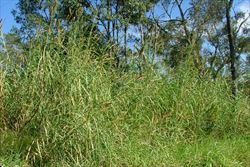
infestation (Photo: Sheldon Navie)

habit (Photo: Sheldon Navie)

habit (Photo: Sheldon Navie)

leaves (Photo: Sheldon Navie)
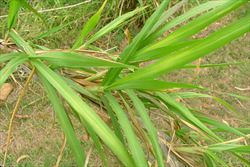
branching and leaves on upper stem (Photo: Sheldon Navie)

stems and leaves (Photo: Sheldon Navie)
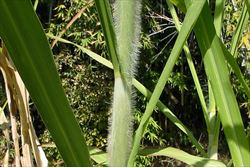
hairy leaf sheaths (Photo: Sheldon Navie)
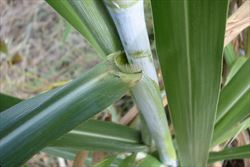
ligule and hairless leaf sheaths (Photo: Sheldon Navie)
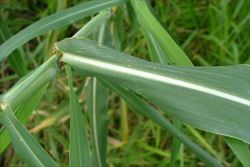
leaf blade with prominent midrib (Photo: Sheldon Navie)
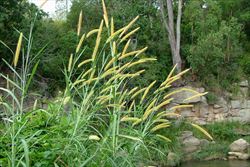
seed-heads (Photo: Sheldon Navie)

young seed-head (Photo: Sheldon Navie)
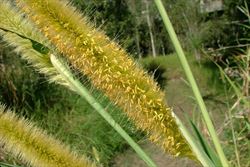
close-up of young flower spikelets (Photo: Sheldon Navie)
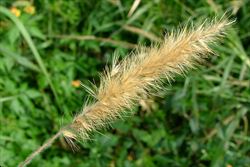
mature seed-head (Photo: Sheldon Navie)

close-up of mature flower spikelets (Photo: Sheldon Navie)

close-up of seeds (Photo: Steve Hurst at USDA PLANTS Database)
Scientific Name
Cenchrus purpureus (Schumach.) Morrone
Synonyms
Pennisetum purpureum Schumach.
Family
Gramineae (South Australia)Poaceae (Queensland, New South Wales, the ACT, Victoria, Tasmania, Western Australia and the Northern Territory)
Common Names
Barner grass, cane grass, elephant grass, elephantgrass, merker grass, Napier fodder, Napier grass, Uganda grass
Origin
Native to tropical sub-Saharan Africa (i.e. southern Ethiopia, Kenya, Tanzania, Uganda, Cameroon, Ivory Coast, Ghana, Guinea, Liberia, Nigeria, Sierra Leone, Togo, Angola, Malawi, Mozambique, Zambia and Zimbabwe).
Naturalised Distribution
This species is widely naturalised in the coastal districts of northern and eastern Australia. It is most common in coastal Queensland and north-eastern New South Wales. Also present in the coastal districts of south-western and northern Western Australia, in the northern parts of the Northern Territory and on Norfolk Island.
Also naturalised tropical Asia (e.g. China, the Philippines, Cambodia, Indonesia, Malaysia, Thailand and Papua New Guinea), southern USA (i.e. California, Texas and Florida), Mexico, Central America (e.g. El Salvador and Honduras), South America (e.g. Colombia and Peru), the Caribbean, and in Oceania (i.e. New Zealand, the Cook Islands, Micronesia, French Polynesia, Fiji, Guam, Kiribati, New Caledonia, Hawaii, Niue, Palau, the Marshall Islands and the Galapagos Islands).
Habitat
A weed of waterways, wetlands, floodplains, open woodlands, forest margins and clearings, pastures, plantation crops, roadsides, disturbed sites and waste areas. It prefers wetter sites in tropical, sub-tropical and warmer temperate regions.
Habit
A robust long-lived (i.e. perennial) grass forming large, bamboo-like, clumps. Its flowering stems (i.e. culms) often grow 2-4 m tall and may occasionally reach up to 7.5 m in height.
Distinguishing Features
- a very robust grass forming large, bamboo-like, clumps (often 2-4 m tall).
- the leaf sheaths are hairless to stiffly hairy and there is a dense fringe of hairs where they meet the leaf blades.
- the large leaf blades (20-120 cm long and 1-5 cm wide) have a prominent whitish central vein.
-
the seed-head is spike-like (8-30 cm long and 1.5-3 cm wide) and very bristly.
-
the flower spikelets are surrounded by numerous bristles, one of which is larger than the others (i.e. 2-4 cm long).
Stems and Leaves
The flowering stems (i.e. culms) are upright (i.e. erect), at least initially, and relatively robust (up to 3 cm thick). They are branched, particularly towards the top, and are somewhat hairy (i.e. distally pubescent). Older stems often produce roots (i.e. adventitious roots) from their lowermost joints (i.e. nodes), and sometimes these long stems fall over and produce similar roots where they come into contact with the ground.
The alternately arranged leaves consist of a leaf sheath, that partially encloses the stem, and a spreading leaf blade. The leaf sheaths are hairless (i.e. glabrous) to stiffly hairy (i.e. hirsute) and are often particularly hairy (i.e. bearded) near where they join to the stem. The narrow (i.e. linear) leaf blades (20-120 cm long and 1-5 cm wide) are generally much less hairy (i.e. glabrous or sparsely pubescent on their undersides). They have a prominent whitish coloured central vein (i.e. midrib), a pointed tip (i.e. acuminate apex), and rough (i.e. scabrous) margins. Where the leaf sheath meets the leaf blade there is a dense fringe of hairs (i.e. a ciliated ligule) 1.5-5 mm long.
Flowers and Fruit
The elongated seed-head (8-30 cm long and 1.5-3 cm wide) is spike-like (i.e. a spiciform panicle) and greenish, yellowish or slightly purplish in colour. It is very bristly and is actually made up of a hairy main stalk (i.e. rachis) with numerous very short branches. Each of these very short branches has a few (1-5) flower spikelets, only one of which produces a seed (i.e. is fertile). These flower spikelets (4.5-7 mm long) are surrounded by numerous bristles (8-16 mm long) in several rows (i.e. an involucre), the outer ones being shorter than the inner ones. One of the bristles is significantly larger than the others (i.e. 2-4 cm long). Each of the flower spikelets have three yellow stamens and a feathery two-branched stigma that is purplish in colour.
When the 'seed' (i.e. grain or caryopsis) is mature, the entire flower spikelet (including the bristles and any other sterile flower spikelets) turns brownish in colour and falls from the seed-head as a whole. The oval (i.e. ellipsoid) or egg-shaped (i.e. ovoid) 'seed' (1.8-2.2 mm long) remains concealed inside the remains of the fertile flower spikelet.
Reproduction and Dispersal
This species reproduces mainly by seed, but can also spread vegetatively via branches (i.e. tillers) and stem fragments. The seeds are dispersed by the wind and can also become attached to animals and vehicles. They may also be spread as a contaminant of agricultural produce (i.e. fodder and seeds).
Environmental Impact
Elephant grass (Cenchrus purpureus) is regarded as an environmental weed in Queensland, Western Australia and north-eastern New South Wales. It is also seen as a potential environmental weed or "sleeper weed" in other parts of Australia.
Legislation
Not declared or considered noxious by any state government authorities.
Management
For information on the management of this species see the following resources:
- the Biosecurity Queensland Fact Sheet on this species, which is available online at http://www.daff.qld.gov.au.
Similar Species
Elephant grass (Cenchrus purpureus) is similar to mission grass (Cenchrus polystachios), African feather grass (Cenchrus macrourus), Deenanth grass (Cenchrus pedicellatus) and swamp foxtail (Cenchrus purpurascens). It can usually be distinguished from these species by its sheer size, but can also be separated by the following differences:
- elephant grass (Cenchrus purpureus) is a very large and robust long-lived (i.e. perennial) grass
(1-7 m tall) with greenish, yellowish or purplish coloured seed-heads.
The main stem (i.e. rachis) of the seed-head is rounded (i.e. terete) and the
bristles below each flower spikelet are relatively long (8-40 mm).
- mission grass (Cenchrus polystachios) is a large long-lived (i.e. perennial) grass (usually 2-3 m
tall) with yellowish or brownish coloured seed-heads. The main stem (i.e.
rachis) of the seed-head is angular and the bristles below each flower
spikelet are relatively long (4-25 mm long).
- African feather grass (Cenchrus macrourus) is a large long-lived (i.e.
perennial) grass (usually 1-2 m tall) with greenish or yellowish coloured
seed-heads. The main stem (i.e. rachis) of the seed-head is rounded (i.e.
terete) and the bristles below each flower spikelet are relatively short
(mostly less than 10 mm long).
- Deenanth grass (Cenchrus pedicellatus) is a moderately-sized short-lived (i.e. annual or
perennial) grass (usually 30-150 cm tall) with pale purplish coloured
seed-heads. The main stem (i.e. rachis) of the seed-head is angular and the
bristles below each flower spikelet are relatively long (6-24 mm
long).
- swamp foxtail (Cenchrus purpurascens) is a moderately-sized long-lived (i.e. perennial) grass (usually 60-100 cm tall) with greenish or purplish coloured seed-heads. The main stem (i.e. rachis) of the seed-head is rounded and the bristles below each flower spikelet are relatively long (15-30 mm long).
Elephant grass (Cenchrus purpureus) is also similar to some of the pigeon grasses (Setaria spp.), including South African pigeon grass (Setaria sphacelata). However, the 'seeds' are shed without the bristles in these species (i.e. the bristles remain on the seed-head).

